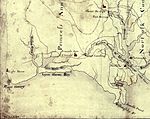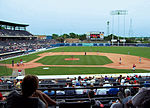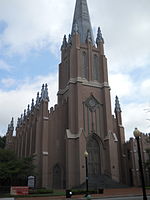Basilica of Saint Mary of the Immaculate Conception (Norfolk, Virginia)

The Minor Basilica of Saint Mary of the Immaculate Conception (also known as the Black Basilica) is a Black Catholic parish in downtown Norfolk, Virginia. It is the oldest parish in the Diocese of Richmond and is known locally as "The Mother Church of Tidewater Virginia". The church was built in 1857–1858, and is a rectangular stuccoed brick church. It features a centrally located, three-stage tower with spire. Also on the property is the contributing rectory. It is a three-story, rectangular brick building in the Late Gothic Revival style.It was listed on the National Register of Historic Places in 1979 and named a minor basilica in 1991. The associated Saint Mary's Catholic Cemetery was added in 2001.
Excerpt from the Wikipedia article Basilica of Saint Mary of the Immaculate Conception (Norfolk, Virginia) (License: CC BY-SA 3.0, Authors, Images).Basilica of Saint Mary of the Immaculate Conception (Norfolk, Virginia)
Holt Street, Norfolk
Geographical coordinates (GPS) Address Nearby Places Show on map
Geographical coordinates (GPS)
| Latitude | Longitude |
|---|---|
| N 36.846944444444 ° | E -76.282222222222 ° |
Address
Holt Street
23504 Norfolk
Virginia, United States
Open on Google Maps










